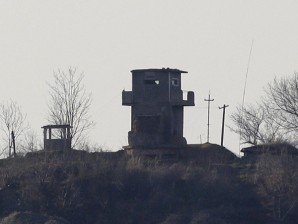
A North Korean military guard post is seen near the border village of Panmunjom, which has separated the two Koreas since the Korean War, in Paju, north of Seoul, South Korea, Sunday, April 7, 2013. AP FILE PHOTO
SEOUL – North Korea appears to be preparing for a fourth nuclear test, South Korea said Monday, following intelligence reports of heightened activity at its main atomic test site.
“There are such signs,” Unification Minister Ryoo Kihl-Jae told a parliamentary committee hearing when lawmakers asked him to confirm the reports.
It was the North’s third nuclear test in February and subsequent UN sanctions that kickstarted the cycle of ongoing escalating military tensions that the international community is desperate to break.
The JoongAng Ilbo daily said South Korean intelligence had detected unusually busy personnel and vehicle movements at the North’s Punggye-ri nuclear test site since last week.
“We are trying to figure out whether it is a genuine preparation for a nuclear test or just a ploy to heap more pressure on us and the US,” it cited an unnamed South Korean government official as saying.
Intelligence reports also suggest Pyongyang has readied two mid-range missiles on mobile launchers on its east coast, and is aiming at a test firing before the April 15 birthday of late founding leader Kim Il-Sung.
A missile launch would be highly provocative, especially given the strong rebuke the North’s sole ally China handed it on the weekend and a US concession to delay its own planned missile test.
Kim Jang-Soo, chief national security adviser to President Park Geun-Hye, said a test-launch could come before or after Wednesday, the date by which the North has suggested foreign diplomats consider leaving Pyongyang.
Japan has ordered its armed forces to shoot down any North Korean missile headed towards its territory, a defence ministry spokesman in Tokyo said Monday.
The New York Times reported that the US and South Korea have drawn up plans for a measured tit-for-tat response to North Korean actions, which will be limited in order to prevent an escalation to broader war.
Citing unnamed US officials, the newspaper said the new “counter-provocation” strategy calls for an immediate but proportional “response in kind” if the North decides to launch a missile or ground attack.
North Korea’s bellicose rhetoric has reached fever pitch in recent weeks, with near-daily threats of attacks on US military bases and South Korea in response to ongoing South Korea-US military exercises.
There has been growing global concern that the crisis could spiral out of control, and China appeared to respond at the weekend to repeated calls for it to take a harder line with Pyongyang.
“No one should be allowed to throw a region, even the whole world, into chaos for selfish gains,” Chinese President Xi Jinping told an international forum in southern China on Sunday.
Although he did not mention North Korea by name, Xi’s remarks were taken as a clear warning to the regime in Pyongyang which is hugely dependent on China’s economic and diplomatic support.
On Saturday, Chinese Foreign Minister Wang Yi had told UN chief Ban Ki-moon that Beijing would “not allow troublemaking on China’s doorstep.”
The United States, which has met the North’s threats with some military muscle-flexing of its own, offered a calibrated concession Saturday by delaying a planned inter-continental ballistic missile test.
A US defence official said Defense Secretary Chuck Hagel had postponed the Minuteman 3 test because it “might be misconstrued by some as suggesting that we were intending to exacerbate the current crisis with North Korea”.
The mid-range missiles mobilized by the North are reported to be untested Musudan models with an estimated range of around 1,860 miles (3,000km) that could theoretically be pushed to 2,485 miles with a light payload.
That would cover any target in South Korea and Japan, and possibly even US military bases on the Pacific island of Guam.
The North has no proven inter-continental ballistic missile capability that would enable it to strike more distant US targets, and many experts say it is unlikely it can even mount a nuclear warhead on a mid-range missile.
Diplomats in Pyongyang huddled at the weekend to discuss a warning from the North’s authorities that their safety could not be guaranteed after April 10 if a conflict broke out.
Most of their governments have made it clear they have no immediate plans to withdraw personnel, and some suggested the advisory was a ruse to fuel growing global anxiety over the crisis.
The one concrete step North Korea has taken is to block South Korean access to the Kaesong joint industrial zone that lies 10 kilometers inside the North side of the heavily-militarized border.
The block remained in place for a sixth straight day Monday.
Originally posted at 10:19 am | Monday, April 8, 2013